Tips for Quality Run Training Train no faster than one pace quicker than the race you are training for. For example, 5k pace is good for an Olympic-distance race, while half-marathon pace suffices...
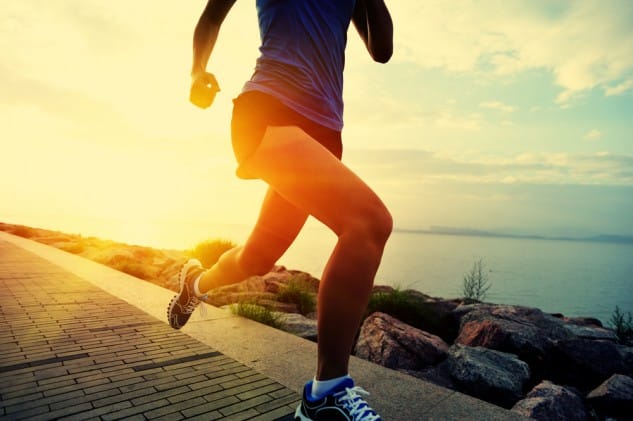

Tips for Quality Run Training Train no faster than one pace quicker than the race you are training for. For example, 5k pace is good for an Olympic-distance race, while half-marathon pace suffices...
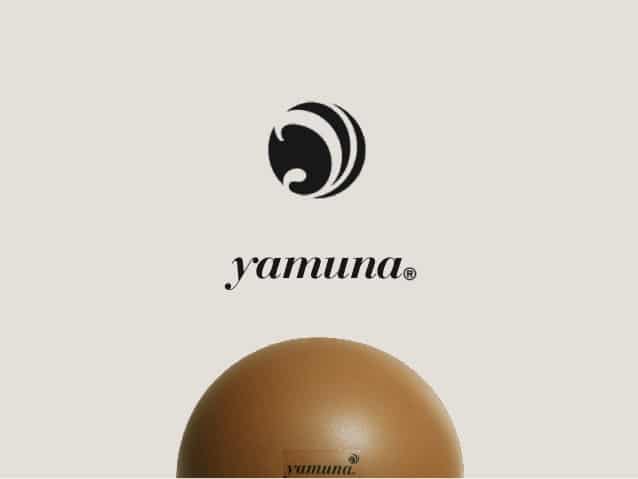
Being immersed in the fitness industry provides me with a ton of different opportunities to experience different techniques, methodologies, and products. I recently had the privilege of a...
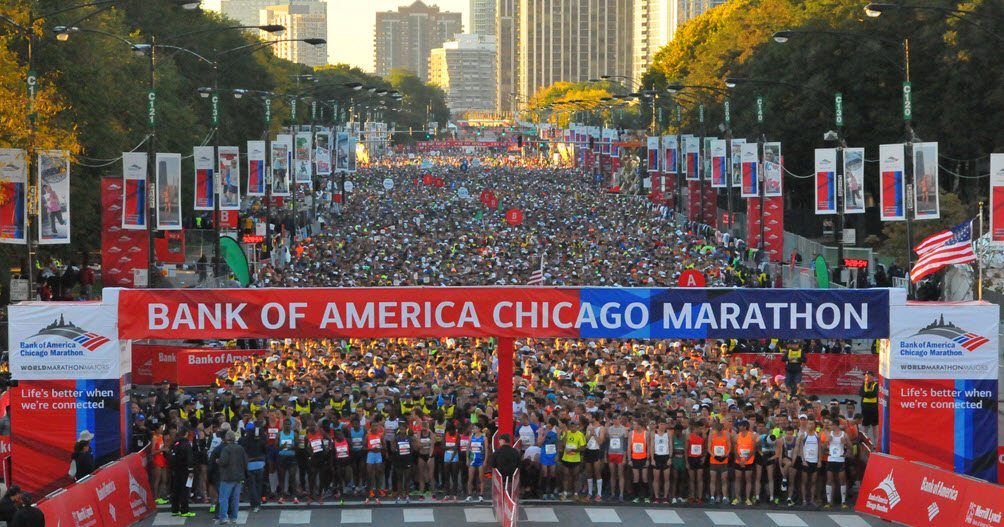
Leading up to the Chicago Marathon 2016 The Chicago Marathon provides an excellent course, plenty of support and, for me, a chance to visit home for a few days. It was no different for me this...

September 25 was going to be my day. The Ironman Augusta 70.3 triathlon was finally here. The race I had been training so hard for on one of my favorite courses. It was four-and-a-half months...
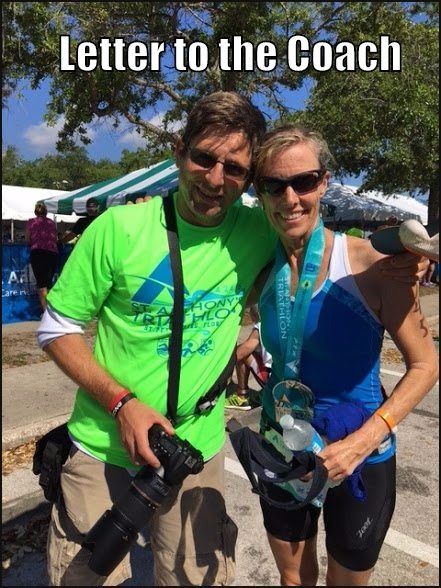
I have been an endurance coach for some time now. Once in a while, I receive an email from a client which chokes me up with pride. Today, I received one of those letters, so instead of sharing it...
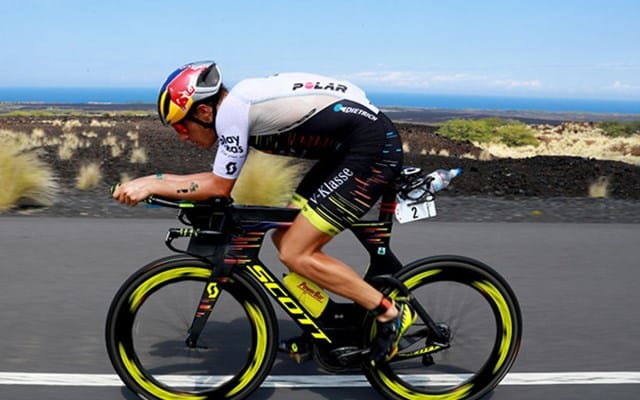
I found when looking for ways to get faster on the bike, is that there is so much information, from different coaches and experts, that it can be confusing and overwhelming. Personally, I...
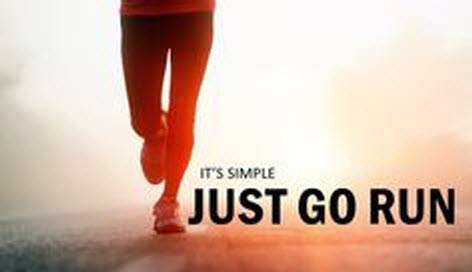
Happy Hump Day! Workout Wednesday’s will consist of favorite workout of mine that I either have prescribed to my clients or have been assigned by MY Coach. It might also be a favorite of yours. Feel free to send me any workouts you like. There will be an objective for every workout for specificity.
I am not a huge fan of weights or being in the gym. As the summer wore on and Florida continued to increase in heat I found myself spending more and more time in the gym and on the treadmill, but I still prefer to be outside. This workout will work leg strength as a replacement for a gym resistance workout or a supplement to. It can be done either on the Treadmill or outside with a hill that takes 2-3 minutes to run up, or here in Florida we use parking garages.
WU (Warm-up): Run Drills & Dynamic Stretching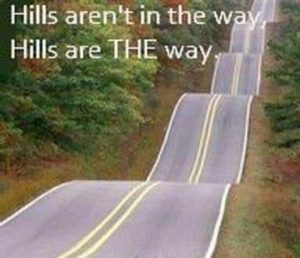
1-2 miles @ conversational pace
MS (Main Set):
Hill Bounders on uphill
Recover for 30 sec – 2 minutes
Speed over strides on Downhill
Repeat for up to 30 minutes
CD (Cool Down): 1-2 miles @ conversational pace
Lunges & Static Stretches
Objective: Leg strength, Aerobic capacity, Form Development & Confidence on Hills
Rate of Perceived Exertion (RPE): 5-7 on the uphills (Talking should be very difficult)
Description: Run a hilly course. Do not try to run fast on the uphills but rather concentrate on a good knee lift, strong arm swing, uplifted chest and full push-off extension in your back leg. Practice running efficiently on the downhills with high turnover and enough of a forward lean that your front leg lands directly under you.
Hill Bounders: go up the hill with a bouncy action and a good posture, concentrating on a good knee lift and arm swing with a “snap” with your ankle. You should be thinking Spring up the hill. Jog until recovered at the top.
Speed Over striders: Run down the hill with out breaking but increasing your cadence with the steepness of the hill. Instead of completely striding out elongating your stride, focus on increasing your cadence with a normal stride.
Biggest Mistakes: Running too fast up the hill rather than concentrating on form. Running too hard up the hill and getting into too much oxygen debt. This is not desirable in this phase .Putting more stress on the legs than they are ready for with too much bounding or downhill running and getting injured. Precipitating your peak with repeated speed bursts. Some people tend to develop speed very quickly once they start doing the hill circuit. If this is the case, go very easy with downhill striding and on the stride-outs. You’ll still have plenty of time to develop speed to maximum. Premature speed development would only lead to premature peaking and this should be avoided.
Warning: The first week of hill training is one of the times where injury is most likely to occur. This is a very demanding exercise, so be overly cautious and feel your way gradually. After about 2 weeks in this phase your legs could feel very tired and you may feel you’re actually slower. This is normal and will pass within a couple of weeks of consistently completing the workout.
I hope you enjoy this one. I know I do.
What kind of workout do you do for run strength?
Carpe Vitam!
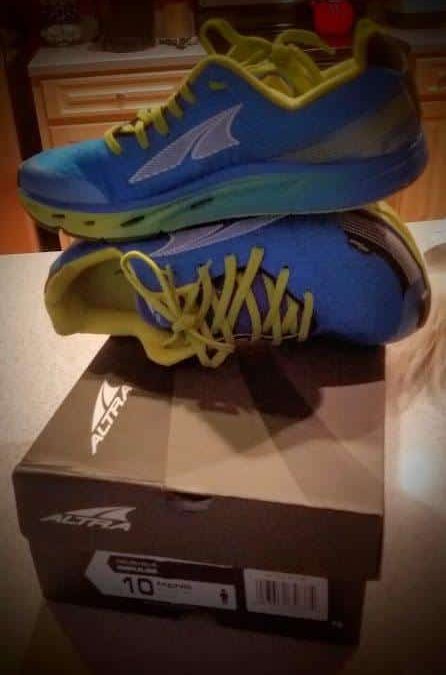

Are you seeing a pattern yet? Yes, I am becoming a huge fan of the 6 year-old running shoe company known as Altra. As I have been instructing clients in form techniques, and have found that most of the models Altra manufactures, lend themselves to my favorite principles.
The Altra Impulse is no different.
As with all of Altra’s models, my favorite advantage is their FootShape™ Toe Box. This is the incomparable wide toe box that Altra is known for. The toe box is makes any of Altra’s models recognizable from a good distance away. That is how wide it is. I enjoy the ability splay my toes and have my feet firmly hit the ground without them being cramped up. Wider toe boxes also allow the feet to develop more strength because the shoe is not tightening around the ball of the foot or the toes. The toes can move around, and tackle all kinds of terrain.
As you can see from the x-ray below, the amount of splay the toes are allowed in the Altra vs a traditional toe box. Imagine having access to the full splay of your foot while you run. What is amazing is that most runners do not even realize the limits that a traditional toe box causes. (Hmm, maybe there is an idea for a full post.)

The Altra Impulse is no different in this department. The FootShape™ toe box has been incorporated and has all the comforts of the other models I have run in.
I love the Zero Drop™ technology that Altra incorporates. When I run I have the ability  to utilize the full power and flexibility of my calf not to mention I can run as if I was barefoot, as our bodies were intended. Most traditional running shoes have a 12mm heel drop. This means that the heel is 12mm above the ball of the foot.
to utilize the full power and flexibility of my calf not to mention I can run as if I was barefoot, as our bodies were intended. Most traditional running shoes have a 12mm heel drop. This means that the heel is 12mm above the ball of the foot.
When we are barefoot, the heel and the ball of the foot are equal which is a Zero Drop™. This also helps with heel striking. Have you ever tried to heel strike while running barefoot? Even if you are a regular heel striker in shoes, it is almost impossible to heel strike while bare foot running. A huge effort has to be made to do that.
So, why runners continue to heel strike? If your heel is more cushioned in the shoe, then of course you will want to hit that area first. (Another post may be needed to explain a little more on this too…stay tuned.)
I love the Innerflex™ which are grooves at the bottom that create a more flexible sole.
One of the huge differences with the Altra Impulse is that they also incorporated their patented StabiliPod™ technology along side the Innerflex™. Now you have a stability shoe that is also somewhat flexible.
I have decided to put this feature as a liked feature more for others than myself. As a pure neutral runner I prefer to work allowing my body to support me, not my shoe, but Altra is marketing this shoe not only for running and triathlon, but for cross training as well.
The StabiliPod™ technology does really help in moving laterally, which is not something that is usual for runners, and especially those of us whom usually stick to the pavement. This is why I do like this feature.
 My absolute favorite feature of this shoe are the drainage holes in the sole. My very last test run with the impulse was an 8 mile run, immediately following a huge rain storm here in Tampa, Florida.
My absolute favorite feature of this shoe are the drainage holes in the sole. My very last test run with the impulse was an 8 mile run, immediately following a huge rain storm here in Tampa, Florida.
My route took me through numerous ankle deep puddles and while my socks remained damp, the shoe was clear of water within a few yards of the puddle. There was no squish from the sole of the shoe or my sock because as my foot pushed down on the shoe, the holes squeezed water out the holes. No more blisters from soaked uppers and water log socks release water as well.
The Altra Impulse also continues with Altra’s A-Bound™/EVA blend compound which sits directly under the foot and adds a return of energy and reduces ground impact.
The upper is a light material and does have a noticeable difference from the other models. The tongue and laces are curved with the shape of the shoe which differs from the straight tongue of traditional running shoes.

I actually enjoyed this new feature. The fit of the shoe felt more comfortable with the tongue falling in the same curve as my foot.
I rarely run without socks, but I did end up having to do go out for a couple of miles one day without socks, and they were extremely comfortable. While the upper is not seamless it is very close. There are only a couple of seems that surround the tongue, but they are covered with a light fabric that helps reduce any friction.
This is probably a very individual issue, but even though I sized up to a 10 from a 9 and a-half, after a few miles my toes still ended up moving forward till I they hit the front of the shoe. This probably has to do with the fact that I only lace my shoes tight enough to lock in my heel.
If you like your shoes laced up tight this probably will not be an issue.
The price point for the Altra Impulse is $120 dollars, which while competitive in the market place it still is a little expensive. In this day and age where people are scrounging for liquidity, I really would like to see at least one company come out with a quality shoe that retails for under $80. Of course that is my opinion and my opinion only.
Quality – 4/5
Upper – 5/5
Outsole – 5/5
Flexibility – 4/5
Comfort –5/5
Appearance – 4/5
Cost – 3/5
Have you ever run in an Altra Running Shoe?
What were your experiences?
Which model do you like best?
Carpe Vitam!
(Seize Life!)
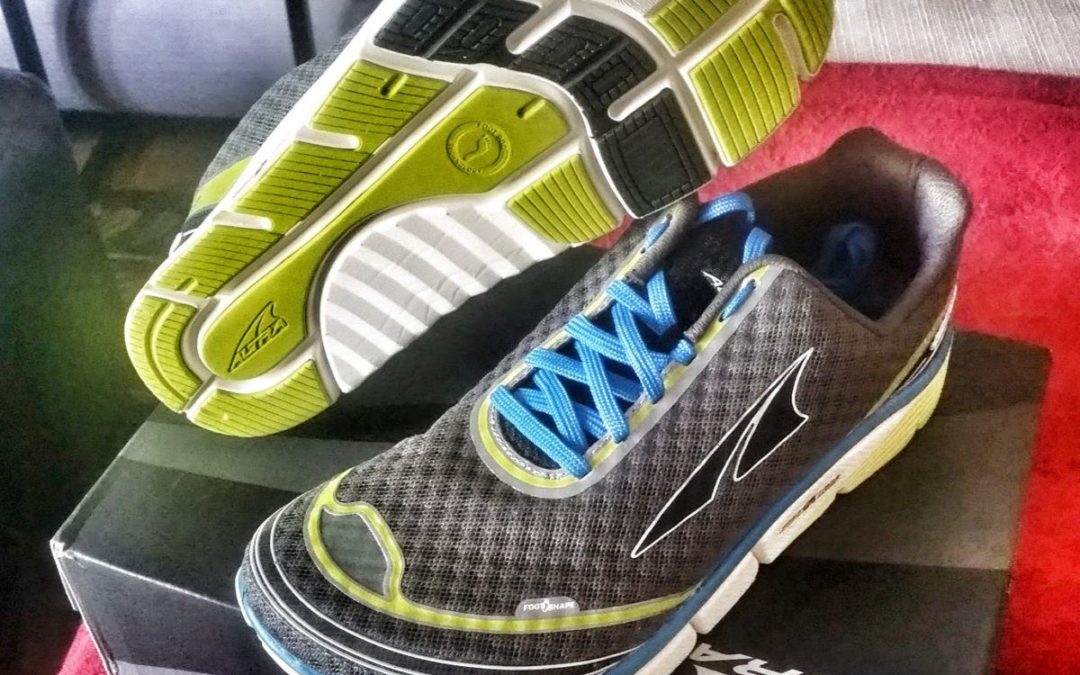
I have been a fan of the Altra line for a little while now, so I was so honored to be given a chance to review the brand new Altra Torin 2. I reviewed the 1.5 version when it first arrived, and it became my shoe of choice for long runs.
One of Altra’s significant differences in the complete line of shoes is their zero heel drop and since my coaching methodology includes an emphasis on our body’s natural movement while running this is obviously one of my favorites. (I have included a explanation of what “Zero Drop” means in my previous Altra Torin 1.5 review.)
The other difference between Altra and their competition is the wide toe box, or as Altra calls it, a “FootShape” toe box. The ability to splay the toes plays a significant role in injury prevention and the strength of the feet. This allows the runners body to support itself, rather tan relying on a shoe for support.
The upper has been improved in the 2.0. The Torin 1.5 was made with a thick upper which added unnecessary weight and reduced flexibility of the shoe. The 2.0 has been upgraded with a much thinner mesh material that breathes better and allows for more flexibility.
Here is where some of my favorite changes were made. First, they moved from the heavier EVA to their lighter proprietary “A-bound” material that for me seems to add a little more spring to the ride of the shoe. When my foot strikes the ground the material seems to not only protect from the natural impact, but reacts driving me forward.
The weight in the previous show was 10.1 ounces which was up from the original Torin which was 9.5 ounces. The Torin 2 comes in at 9.1 ounces which is one of the lightest in this category, if not the very lightest.
Altra added what they call Innerflex which are groves in the outsole and midsole that bend with your foot allowing substantially more flexibility than the previous models. This too me was the single most important change they made. The Torin has always classified as their High Cushioned shoe which most companies have traded flexibility for cushion. Altra has found a way to give runners the flexibility I love with the cushioning I want and without giving up any of proprioception.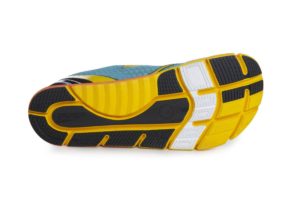
The have now included a Foot Pod technology which maps the bones of the foot with the Innerflex so the shoes flexes where the runner needs it to, allowing a near customized fit.
Altra went ahead and removed the toe guard and heel rudder as well. In my opinion this not only allowed them to shed some weight, but also added to flexibility and comfort. In a road shoe I never really thought either added any value. These two advantages are best left for trail specific designs.
Obviously, not much.
The new Abound foam tends to soak in water and sweat which makes the shoe feel a little heavier during training and racing. Even with the mesh material the shoe does not seem to drain well. I would love to see a version of this shoe with drain holes, but of course that is the triathlete in me talking.
After about forty miles the new Abound material started to squeak while just walking ,and only in my left shoe This does not seem to happen when I run in them, but it is a little noisy when walking through the store. I think it may be just a problem with this pair, but nonetheless it is something I dislike. However, it did not change the performance of the shoe.
The price of $125 is a little high in my opinion. A better price point would be the $100 – $110, but of course that is very minor for shoe of this quality.
Let’s see how the Torin 2 ranked on my scale:
Quality – 4/5
Upper – 4/5
Outsole – 4/5
Flexibility – 5/5
Comfort – 5/5
Appearance – 4/5
The Altra Torin 2 is available in men’s whole and half sizes 7-12.5, whole sizes 13-15 and in three color patterns. It is available in women’s whole and half sizes 5-10.5, whole sizes 11-12 and in three separate color patterns.
Please feel free to comment on your feedback.

It has been a while, and I have a ton of ideas that I am anxiously awaiting to share with you. Unfortunately, time has been getting away from me. Between training myself, a full-time job and being at capacity with 15 individual clients I am struggling for time to post. I promise I will figure out a way to make time. I am so lucky to have such great people to bounce ideas off of, that sometimes, by not posting, I feel like I am letting all of you down, so I promise to post more even if the posts end up being a lot shorter than usual. (Which the length is probably not your favorite part of it anyway. I know I ramble.)
Before I get into the nitty-gritty of my personal opinion of compression, a disclaimer.
I am not a medical professional. The opinions that are shared on this post come from research, my own experiences and the experiences of athletes I have personally witnessed and information I have researched. Every athlete/person has a different body and some products and/or methodologies may be advantageous for some and may even be dangerous for others. This post deals with my beliefs and my research. (Was that clear?)
Lately, most of the questions from other athletes, including clients of mine, have asked about compression. This usually centers around calf sleeves, but does include some of the other compression apparel as well. My answer is usually, for recovery and for temporary use they are great, but not for training. Why? Great question.
I am going to use calf sleeves as my example.

While running, biking, swimming or any major activity using the legs, the muscles are constantly in motion. That motion is what naturally makes the muscles stronger. The muscle moves and is loaded with either more repetitions, or with weight. The full range of motion of each muscle is imperative to the strengthening of the muscle. Compression holds that muscle in place and limits the movement therefore limiting the range of motion. While compressed the muscle cannot fully develop while training. Let’s take a look at the anatomy of the lower leg in the running position.


As you can see the gastrocnemius muscle and Achilles tendon, when the knee is flexed, both constrict and then elongate when the knee straightens. Here is the epitome of the range of motion naturally occurring when running. The more flexion and constriction that take place the more they are stretched causing the breakdown of the fibers. After the recovery period the fibers wrap tighter and in more abundance aiding in a strength and endurance. Now imagine that gastrocnemius muscle remaining constricted due to a calf sleeve. It seems to me that this would dictate that it would not have full range of motion also causing the Achilles tendon to remain stretched without the full ability to absorb the impact. This could unintentionally damage the Achilles tendon, the gastronemius muscle and the soleus muscle. If not damage, it will limit the ability to be strengthened. This is why I personally do not recommend calf sleeves during training workouts.
Recovery
I do however do not mind wearing compression while in recovery to include immediately following the cool down of a workout. I mentioned the healing of the fibers earlier. In order for the fibers to heal and become stronger after the breakdown, blood must be pumped through the muscle and with it water for hydration. Compression does help to isolate that area helping to keep the majority of the blood and water being pumped through the body to the point of the compression. With the legs either elevated or even walking around and at that point limiting the movement, it would allow for the blood to pool in that area helping to re-hydrate the muscle thereby helping to heal faster. In turn, an occasional training run or race, with compression at the tail end of an injury, might also benefit, but in a very limited quantity, and duration.
–IronGoof

It’s that time again. The beginning of the new year and time to set some new goals. Notice I am stating resolutions, these are goals. In my experience, the best way to set new goals is to make sure that each one of them is SMART.

Coach Brad with the Iron Goofy
S- Simple
M- Measurable
A – Achievable
R – Realistic
T – Timely
Let’s take a look at the last year 2013-
1. Get over my fear of leaving my day job and get my business off the ground. – Business is good, I have had up to 13 clients with 9 still with me after the tri season was over. I have 3 that have contacted me wanting to start in March. With a full-time job, it keeps me busy. Luckily a few of these are virtual so most of the work is email, phone and Training Peaks.
2. Reduce debt by minimally 50% – Complete – Actually more like 75%
3. Re-commit to a financial plan and budget – Complete – see #2
3. Complete my Certified Personal Trainer, USAT Level 1 coach, and USATF Level 1 and minimally begin my Certified Nutrition Professional. – Complete except for CNP (*also added RRCA, Newton & Lydiard Certs)
4. Blog at least 5 times a week – Unfortunately, this did not happen more like once, but will re-commit for this year to at least 3.
1. 2 Ironman Triathlons: IM Louisville, IM Florida – IM Florida, but IM Louisville turned out to be more financial 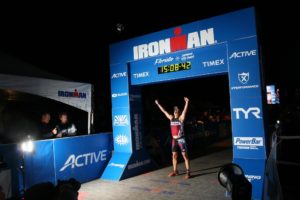 then not trained.
then not trained.
2. IM FL in less than 12 hours – This one was discouraging. Read about it. – I am thinking about doing another one for vindication.
3. Running average pace at 7:30 min/mile at RPE 2 – I got to about 7:45 for a 10k
4. Biking average pace at 22 mph at RPE 2 – Complete – hit this at IM Augusta
5. Swim at 1:45 per 100m at RPE 3 – Incomplete – will have to focus more on the swim this year
6. Start CrossFit as strength training – Started it, but stuck to more of a Lydiard method. Will be incorporating at least once a week during strength phases.
7. 1 half-marathon at 1:35 or less – 1:43 was still my best. Have to dedicate to this one again
The score is 8 out of 13 completed with each at least attempted. I would consider it a successful year, but I would like to do better.
1. Completely eradicate debt
2. Start another passive income stream with the possibility for full-time income. (already started actually)
3. Have a plan by the end of the year for leaving my full-time job
4. Communicate more with family
5. Start a financial plan for the future
6. Understand more about SEO and Internet Marketing
7. Blog 3x per week minimally
8. Complete CNP, USAT Youth & Juniors, USAT Official and start CSCP certifications
9. Less take-out and dining out, more cooking. (25 out of 30 days a month)
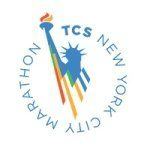
1. New York Marathon – 3:40 or better
2. Half Marathon – 1:35 or better
3. Conversational pace at 7:30
4. Complete 2014 miles ran
5. Possible Vineman Ironman Distance?? (Vindication Race)
6. Complete two 70.3 triathlons
7. Swim at 1:45 per 100 for 2 miles
8. Inaugural ITU Chicago Triathlon – 2:25 or better
9. All members of the TNT I am coaching crossing finish line at both Nike Women’s and RnR San Diego
10. First – Complete Dopey Challenge with a smile.